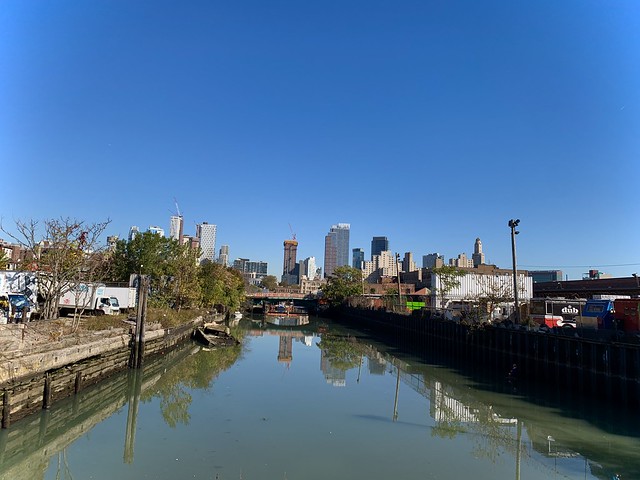Christos Tsiamis, EPA's Gowanus Canal project manager
On Tuesday, January 28, the Environmental Protection Agency (EPA) issued a Unilateral Administrative Order to the six major corporations that bear the most significant responsibility for the canal's pollution. The order compels these Responsible Parties to begin the important work of dredging and capping of the upper portion of the Gowanus Canal and to restore the First Street Basin, which was illegally filled a few decades ago.Christos Tsiamis, the EPA project manager, began the lengthy and detailed presentation by saying:
"It has been a long time coming for me and for you, this moment when I stand here in front of you to discuss specific steps that we will take for cleaning up the canal in a timeframe that is within sight. So I am very happy to be here tonight."
Indeed, it felt like a huge milestone to finally be talking about dredging the main canal after so may years of planning.
With the lessons learned during the Pilot Study in the Fourth Street Basin near Whole Foods in 2018, the EPA has made some adjustments to the original clean-up plan and estimates that the work on Remediation Target Area 1, which covers the top of the canal from Butler Street to the Carroll Street Bridge, will begin sometime in late August/ September of 2020.
The work, as Tsiamis explained yesterday, needs to be carefully choreographed. Before the toxic material at the bottom of the canal can be removed, new bulkheads need to be installed to provide structural support to the shore. Also, work on the Fulton Bulkhead Barrier Wall Construction at the head of the canal is still ongoing. The sealed wall will serve as an environmental barrier, preventing liquid coal tar from the former Fulton Manufactured Gas Plant from recontaminating the canal after the Superfund clean-up is completed.
The work on this upper portion is expected to take about 30 months and is estimated to cost $125 million. Upon its completion, the clean-up will continue on the middle and lower parts of the canal.
With the lessons learned during the Pilot Study in the Fourth Street Basin near Whole Foods in 2018, the EPA has made some adjustments to the original clean-up plan and estimates that the work on Remediation Target Area 1, which covers the top of the canal from Butler Street to the Carroll Street Bridge, will begin sometime in late August/ September of 2020.
The work, as Tsiamis explained yesterday, needs to be carefully choreographed. Before the toxic material at the bottom of the canal can be removed, new bulkheads need to be installed to provide structural support to the shore. Also, work on the Fulton Bulkhead Barrier Wall Construction at the head of the canal is still ongoing. The sealed wall will serve as an environmental barrier, preventing liquid coal tar from the former Fulton Manufactured Gas Plant from recontaminating the canal after the Superfund clean-up is completed.
In addition, the Union Street Bridge and the landmarked Carroll Street Bridge need to be stabilized with pipe piles in order to not compromise them during dredging. The Carroll Street bridge will most likely stay in an open position for three to four months and will be closed to traffic. The Union Street Bridge, however, will be passable.
Once all the support work has been completed, dredging of the soft, toxic sediment at the bottom of the canal will begin between the two bridges.
One major change in the clean-up plan has to do with the capping, which serves to keep toxins deep in the native soil from percolating back up into the water after the dredging. As Tsiamis observed as part of his work on the canal, there is a significant amount of upwelling of ground water. In order to deal with this, the contractor will:
-first dredge most of the contaminated soft sediment and debris
-inject a cement layer into the most contaminated pockets of native sediment to stabilize these areas
-add an oleophilic clay layer
-add granular activated carbon (to absorb any chemical pushed up from below) and a sand layer. The thickness and content will vary to match the expected dissolve phase flux through the cap and to provide an even surface for the top.
-finish with an articulated concrete armor top
Most of the toxic dredged material will be transported out of the community by barge on the Gowanus to New Jersey where there is sufficient space to separate and treat it before disposal.
The work on this upper portion is expected to take about 30 months and is estimated to cost $125 million. Upon its completion, the clean-up will continue on the middle and lower parts of the canal.
Tsiamis told the CAG that work on the design for RTA2, the most polluted part of the canal, is already underway.
This big step signals the true beginning of the clean-up of this long neglected waterway. It will be a pretty momentous occasion for Gowanus and for this community.



















.JPG)

4 comments:
excellent summary, thank you!
George Fiala
Thanks, George. Hope to see you at next month’s meeting. Things are getting interest
Thank you, Katia, for your detailed updates. I have a class on Wed eves so I can't often attend these meetings, but do you know:
- will they drain the canal before beginning work?
- will the "floor" be higher when it's finished?
Jim P
Great to see this update. Thank you for the report.
Post a Comment